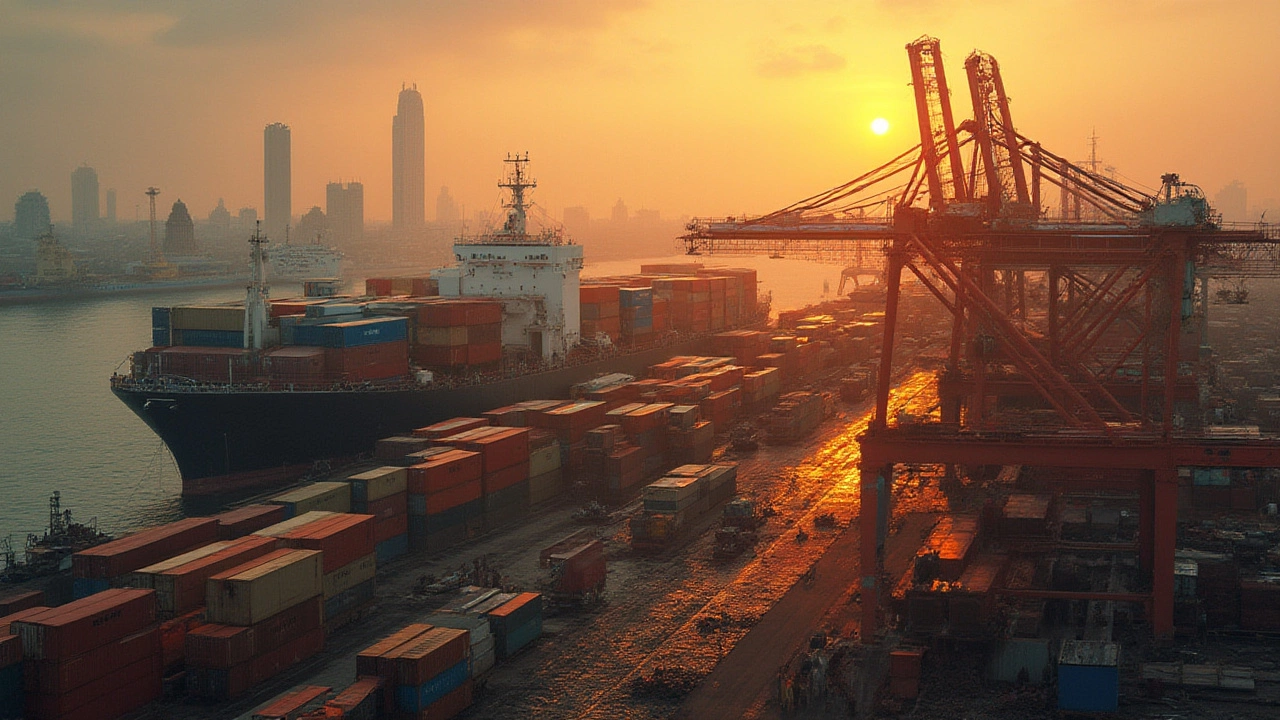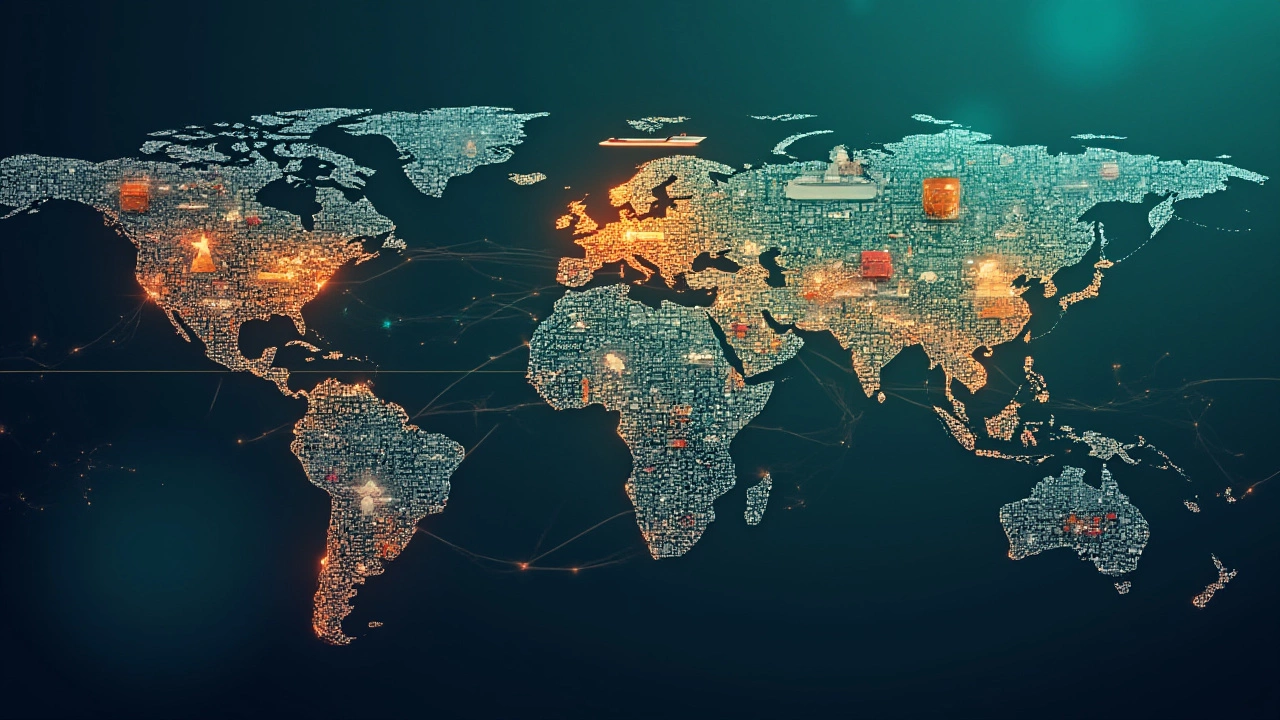India’s Trade: Types, Trends, and Key Facts for 2025

Try wrapping your head around this: India ships out over $400 billion worth of goods each year and brings in even more. That’s not pocket change—it's a tidal wave of economic activity. But here’s what trips a lot of people up: what type of trade does India actually do? Is it heavy in high-tech, all about spices and textiles like the history books say, or something else? If you’re picturing crates of tea and Bollywood songs as India’s biggest trade items, well, the story gets a lot more interesting.
Understanding India’s Trade Structure
When people ask about India’s trade, the first thing to know is there’s both foreign and domestic trade at play. The big deal everyone talks about is foreign trade—the buying and selling of goods and services across the Indian border. And here’s the fun bit: India’s trade today looks nothing like it did fifty years ago. Exports used to be mostly textiles, tea, and jewelry. Now, India sends out cars, computers, even satellites.
Let’s break this down. India operates with two main trade formats: merchandise trade and service trade. Merchandise means all the physical stuff—think cars, oil, steel, rice, and medicine. Service trade covers things you can’t touch, like software, consulting, and IT support. Ask anyone in Bengaluru, and they’ll tell you the software export scene is on fire. India’s service trade brings in more than $300 billion a year, making it the fastest growing segment. Surprisingly, the country is now the world’s top exporter of IT services. I’m talking big names like Tata Consultancy, Infosys, and Wipro. If you’ve called customer support lately, it could’ve very well been routed through India.
On the flip side, India imports a ton of oil, electronics, and gold. Here’s why—over 80% of its energy comes from imported crude oil. Without those barrels of foreign oil, the trucks, buses, and rickshaws would grind to a halt. Electronics are the next giant; iPhones, semiconductors, and TV screens flow in from China, South Korea, and elsewhere, fueling the digital dreams of 1.4 billion people.
Domestic trade also hums along strong. Within the borders, you’ll find a buzzing marketplace connecting over 28 states and 8 union territories. Trains and trucks move grain, clothing, cars, and countless products, giving every corner of the country access to what it needs. The Goods and Services Tax (GST), launched in 2017, stitched the whole market together, making internal trade faster and easier than ever.
The mix doesn’t stop there. India signs Free Trade Agreements (FTAs) with countries like Japan, South Korea, and the United Arab Emirates. These deals mean certain goods get in and out without huge taxes or hoops to jump through, making Indian goods cheaper abroad and foreign goods easier to buy at home. There’s a huge focus on boosting exports and reducing imports (especially oil and gold) so that money flows in, not just out.
To give you a clearer picture, here's a quick look at India's top 5 exports and imports for 2025 based on recent data:
| Top Exports (2025) | Top Imports (2025) |
|---|---|
| Petroleum products | Crude oil |
| Gems and jewelry | Electronics |
| Pharmaceuticals | Gold |
| Automobiles | Machine parts |
| Apparel & Textiles | Chemicals |
It’s wild to think pharmaceuticals are up there, but India is known as the “pharmacy of the world” for a good reason—in 2024, it shipped out life-saving drugs to more than 200 countries, including the US and Europe. All of this shows India’s trade is a fast-shifting, multi-lane highway rather than a sleepy backroad with donkey carts full of spices.

Export and Import Trends Shaping India’s Economy
Ready for some numbers? According to India’s Ministry of Commerce and Industry, the country’s exports hit $437 billion in goods and $324 billion in services in the last financial year. The import bill went even higher, mostly because of the rising cost of oil and gold. That means India runs what’s called a “trade deficit”—it spends more on imports than it makes from exports. This isn’t always a bad thing, but it does put pressure on the country’s currency and foreign reserves.
Now, here’s a fun twist: while India has a trade deficit in goods, it actually has a surplus in services. That’s right—thanks to all those IT and business process outsourcing contracts, India makes more selling services abroad than it spends buying. You won’t see that on most news headlines, but it’s a game changer for balancing the books. Services include call centers, software development, digital marketing, and even architecture and design. In fact, digital marketing is shooting up as a big export—so much so that some Indian firms now run campaigns for US and UK brands almost entirely from cities like Mumbai and Gurugram.
But that’s just the big picture. The details get juicier. Let’s talk agriculture. India is the world’s biggest exporter of rice and spices—black pepper from Kerala, turmeric from Tamil Nadu, and basmati rice from Haryana. These products are famous worldwide and are often protected by “geographical indication” tags, meaning no other country can claim the same names. My wife Megan still talks about the fresh basmati rice we picked up on our last trip to India—nothing beats the aroma of the real deal.
Beyond food, the country is flexing its muscles in automobiles and machinery. Tata and Mahindra are now shipping cars and trucks to Africa, South America, and even some parts of Europe. Local car brands are making a splash on the global stage. Meanwhile, pharmaceutical exports have exploded—India now accounts for 20% of the world’s generic drug exports, reaching even remote hospitals in Africa and South America.
The government isn’t sitting still. Initiatives like “Make in India” and “Atmanirbhar Bharat” (Self-Reliant India) push local industries to innovate and compete globally. Multi-billion dollar investments in renewable energy and digital infrastructure are transforming what India trades, both in products and in know-how. Solar panels are becoming a new export hit, while big investments in space and defense tech are opening opportunities few expected a decade ago.
One catch: trade isn’t exactly even. Over 50% of India’s exports go to just 10 countries, like the US, China, the UAE, and the UK. So, if the global economy sneezes, India could catch a cold. The country is working hard to diversify by exploring new markets in Africa and Southeast Asia, and by signing new trade deals almost every year.
And don’t forget e-commerce. India’s online sellers are now exporting fashion, handicrafts, and small electronics using platforms like Amazon and Flipkart. Even my neighbor, who sells handmade scarves, ships orders as far as Germany. Technology isn’t just helping big companies; it’s boosting small-town businesses and craft artisans too.
So what changes are coming? Experts are betting big on “green” exports—solar, wind, electric vehicle parts—and digital services. Water-conserving agricultural products and next-generation pharmaceuticals are lining up as the next breakout stars. With climate change and tech innovation both on fast-forward, the next five years should see India’s trade profile look even more modern than the world expects.

Key Tips and Surprising Facts About India’s Trade
If you work in business or plan to get into international trade, India’s variety can be both exciting and intimidating. Here are a few tips and quirks that I find useful, especially if you want to partner, invest, or just understand how this trade juggernaut works up close:
- Timing matters. India’s financial year runs from April to March, not January to December. That means all the official trade numbers follow a slightly wonky calendar cycle.
- Look beyond the big cities. Sure, Mumbai, Delhi, and Bengaluru are trade powerhouses, but small towns in Gujarat and Tamil Nadu are turning into export hubs for diamonds, machinery, and textiles.
- Language and culture can be assets. English is widely used in business, making deals far smoother than in other emerging economies.
- Regulations shift, so keep an eye on new import-export rules, GST rates, and government incentives—especially during annual budget season in February.
- Watch tech trends. Digital goods and services are India’s fastest-growing export category. E-learning, telemedicine, smart farming solutions—these aren’t just buzzwords, they’re big money.
- Sustainability sells. Products with a “green” certificate or fair-trade label fetch higher prices and have a better shot in Western markets.
- India is a major player in global supply chains for pharmaceuticals, textiles, and gems. So global shocks—like pandemics or wars—hit India hard but also push local innovation fast.
- Ports matter more than you think. Over 90% of foreign trade by volume passes through India’s seaports, with Mumbai’s Jawaharlal Nehru Port and Chennai’s port handling the bulk.
Dive into India’s trade scene and you’ll see more than exports and imports—you’ll find big ambitions, local innovation, and a country reshaping how it works with the world. Maybe next time you spot a new gadget, bottle of medicine, or embroidered scarf in your neighborhood, you’ll know it just might have made the journey from the heart of India to your doorstep. And if Charlie, my dog, ever gets a new toy with “Made in India” stamped on it, I’ll be the first to show him how trade makes it all possible.

Post-Comment